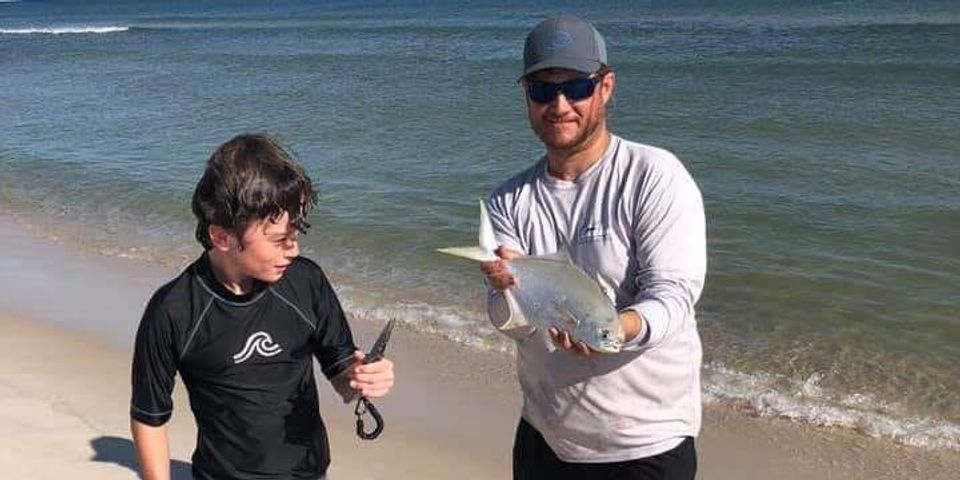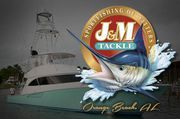
Winter Surf Fishing in Alabama
by Blake Michaleski
Surf fishing along Alabama’s white sand beaches can be an exceptionally affordable and fun way to fish without the expense of a boat or hiring a guide. Winter is a very popular time to fish in the surf in Alabama as the less desirable “trash fish” are not as common during the cooler months. Hardhead catfish and stingrays have moved out to deeper waters, increasing the chances of you landing a quality food fish such as pompano or even a hard fighting sport fish such as bluefish. Whether you are one of our winter-time “snowbird” visitors or a local enjoying where you live, surf fishing is a great way to have fun and pick up some fine table fare from our coastal waters.
Popular target species in the cooler months of December - March using still fishing techniques include the Florida Pompano, Gulf Kingfish (commonly known as “whiting”), red drum (commonly known as redfish), and black drum (smaller, better eating size known as “puppy drum”). Increasingly permit, a fish native to more tropical waters and a prized flats and fly species, are being caught. Alabama currently does not regulate this species but it is good conservation practice to observe the size and creel limits set by Florida. Incidental catches of bluefish and flounder are possible still fishing but can be targeted with jigs.
Generally speaking, anywhere along Alabama’s beaches are good for surf fishing. Water tends to be clearer to the east as you go towards Florida and muddier to the west around Mobile Bay. Water clarity also varies by tides, incoming being cleaner, especially near inlets. Areas closer to or just inside the beach inlets such as Perdido Pass in Orange Beach, Little Lagoon Pass or “West Pass” in Gulf Shores, and Mobile Bay at the tip of the Fort Morgan peninsula are going to see higher concentrations of fish. Fishing in the passes may give more opportunities for flounder and redfish specifically but pompano can be found anywhere along the open stretches of beach. Anglers fishing in the passes near the jetties and seawalls will find sizable aggregations of sheephead, which are excellent table fare. One of the most common baits used for surf fishing is fresh dead shrimp, with larger bait shrimp being cut into smaller pieces. Nearly everything eats dead shrimp. A negative to using dead shrimp is that they are often soft and do not stay on the hook well, sometimes coming off when the rig hits the water on a long cast. Mole crabs, locally known as “sand fleas”, are another popular natural bait but require digging or “raking” them from the surf zone using specially designed sand flea rakes. This adds a significant amount of work to an otherwise relaxing fishing trip. Hard-core pompano anglers will put in the work to catch sand fleas as this is the predominant forage species of pompano. Fresh is best, but pompano will take previously frozen sand fleas. A newer and popular alternative is a synthetic product called “Fish-Bites” that utilized a mesh strip to keep the bait on the hook longer. Pink shrimp and sand flea are two very popular varieties for our local beaches. Another very effective natural bait for pompano and other surf species is the ghost shrimp. This burrowing shrimp has a very soft body but tends to stay on the hook better than common shrimp. They are extracted from the sand right at the waterline with a PVC apparatus known as a “shrimp-slurper”. Shrimp-slurpers are available at J&M Tackle, and kits are often available at local hardware stores for the do-it-yourselfer. Anglers targeting red drum specifically often use cut fresh mullet or cracked blue crab when available. Artificial jigs are popular for anglers targeting bluefish and flounder with both taking a variety of styles. Technique is different for these two species with bluefish preferring a faster retrieve higher in the water column, while flounder can be taken hopping a jig along the bottom. Any jig that resembles a small fish will do the job, but everyone has their favorite.
Fishing tackle for surf fishing does not need to be expensive. The harsh environment of salt spray and wind-blown sand makes for a situation where high dollar reels are best left at home. Nearly any rod ranging from 7’ to 9’ will give you the distance and power to fish for all of the beach species. The steeply-sloped beaches and close proximity of the sandbars means you don’t have to cast very far. Novice beach angler in the area often cast past the fish without even knowing it. For still fishing with bait and the rod in a sand spike rod holder, an 8’ or 9’ spinning rod rated for 10-20 pound monofilament is more than adequate. Pair this with an inexpensive 5000 or 6000 size reel with 16# monofilament or 30# braided line and you can easily target most beach species. For throwing jigs and other lures, a 7-8’ rod rated for 6-14# monofilament and a 2500-3000 size reel spooled with 12# monofilament or 15-20# braid is ideal. Rigs used for pompano are typically 20-30# monofilament “double-dropper rigs”, often incorporating small brightly colored floats as a visual attractant for pompano and whiting. These rigs use either a standard “pyramid” sinker though some seem to prefer the newer style “storm” sinker as it will hold the bottom better in current and waves with less weight than a pyramid sinker. For throwing jigs in the cooler months, a 3-4’ piece of 30# fluorocarbon leader attached to the mainline gives some additional protection against being cut-off over tying to your mainline alone. Blue fish can still get through this type of leader. If the bluefish are the predominant catch, consider a short piece of light wire leader. When it comes to weather and tides, many anglers fish when they can. If you can plan trips around the conditions, it can improve the odds for success. An incoming tide will generally encourage fish to move in towards the close sandbars and will bring cleaner water versus an outgoing tide, especially near passes. Pompano tend to prefer clearer water as they feed by sight, whereas redfish feed by sight and scent, they tend to be less particular about water clarity. Ideal weather along the Alabama Beaches would be light winds with a northerly component. Often the south winds will strengthen ahead of approaching cold fronts and drive the surf higher, making beach fishing difficult to impossible. Some waves are good as they create breaks in the sand bars with outgoing rip currents. This can be a good place to fish as it generally concentrates forage species of sand fleas and small fish that the larger, target fish will be feeding on.
J&M Tackle can set you up with the tackle, bait, and know-how to help make your beach fishing trip a successful one!
Consult outdooralabama.com for up-to-date size and creel limits.
About the Business
Have a question? Ask the experts!
Send your question

